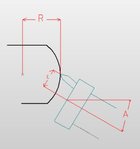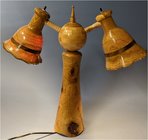This may be the forum's first posting of an OT technique...
This is a way to make the end of your work piece hemispherical. The work is rotating slowly, but not rocking by a rosette. The cutter would be rotated at high speed by an overhead drive belt like used for cutting frames. The cutter is fed slowly into the work using your machine's cross slide tool holder.
The angle A of the rotating cutter with respect to the lathe spindle axis is :
arcsin of c/R, where "c" is the cutter radius and R is the desired workpiece radius.
This is something that's done on milling machines to make accurate hemispheres with the cutter tip positioned exactly over the center point of the hemisphere location. That works well on homogeneous materials. But for wood with grain the cutter has to be positioned slightly off center so it only cuts with the grain. Looking down on my crude diagram that would mean the cutter has to be slightly below (or above) the work's center of rotation depending which way the cutter is rotating.
BTW: I did the calculation from memory so if it's wrong let me know.
This is a way to make the end of your work piece hemispherical. The work is rotating slowly, but not rocking by a rosette. The cutter would be rotated at high speed by an overhead drive belt like used for cutting frames. The cutter is fed slowly into the work using your machine's cross slide tool holder.
The angle A of the rotating cutter with respect to the lathe spindle axis is :
arcsin of c/R, where "c" is the cutter radius and R is the desired workpiece radius.
This is something that's done on milling machines to make accurate hemispheres with the cutter tip positioned exactly over the center point of the hemisphere location. That works well on homogeneous materials. But for wood with grain the cutter has to be positioned slightly off center so it only cuts with the grain. Looking down on my crude diagram that would mean the cutter has to be slightly below (or above) the work's center of rotation depending which way the cutter is rotating.

BTW: I did the calculation from memory so if it's wrong let me know.
Last edited:

